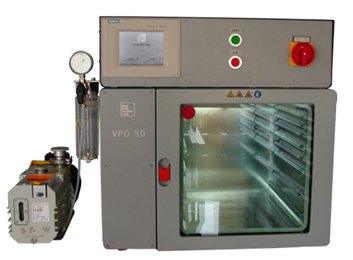Document Responsible: Bjarke Rolighed Jeppesen
Date: 15 June 2021

1) Purpose/Formål
The purpose of this APV instruction is to ensure that users, in the iNANO cleanroom, are aware of the potential dangers that exist when working with the HMDS oven. Users should be aware of the potential hazards listed below. The aim of this APV instruction is also to prevent personal injury to maintenance personnel.
2) The Instrument/Instrumentet
Hydrophilic surfaces such as silicon dioxides, silicon nitrides, glass samples, and certain metals that have surface oxides adsorb a few monolayers of water. Polymeric photoresists are very hydrophobic with poor adhesion to hydrophilic surfaces which often have surface adsorbed water. The HDMS oven can promote the adhesion between photoresists and samples with hydrophilic surfaces. The oven is a vacuum instrument that can be filled with priming chemical vapor.
The vacuum chamber can be heated to 200 degrees C. The instrument carries out the following process; after loading the wafers/samples into the oven, the chamber is evacuated to a pressure of 2 mtorr, and the wafers/samples are heated to 170 degrees C. At this temperature, water molecules on the surface evaporates. This step in the process is referred to as “the dehydration step”. Subsequently, the priming chemical HMDS vapor (bis(trimethylsilyl)amine, also called hexamethyldisilazane (HMDS)) is introduced into the vacuum chamber. The HMDS reacts with oxygen groups on the sample surface and forms a monolayer of (CH3)3-Si-O groups. The process in the HMDS oven is completed by nitrogen purge and evacuation cycles to remove any excess HMDS from the oven. After a completed process in the HMDS oven, the surface on the wafers/samples are coated with chemical groups that are covalently linked to oxide groups on the sample surface and render the sample surface hydrophobic for promoting the adhesion of resists.
3) Hazardous Conditions/Risiko
The oven can be hot and cause burns.
4) Protective Clothing/Beskyttelsesdragt
For normal process operation standard cleanroom protective clothing must be worn. For handling HMDS reagent, the super-user is required to use facemask and protective gloves that are resistant to HMDS.
5) Identification/Identifikation
The following chemical is used in the HMDS oven:
Toxic: HMDS (bis(trimethylsilyl)amine or hexamethyldisilazane). Find sds in Kiros.
Only the super-user is allowed to load the HMDS reagent. HMDS is contained in a 500 mL glass container and labelled with the below pictograms:
Hazard statements from Material Safety Data Sheet (MSDS):
H225 Highly flammable liquid and vapor.
H302 + H332 Harmful if swallowed or if inhaled
H311 Toxic in contact with skin.
H314 Causes severe skin burns and eye damage.
H412 Harmful to aquatic life with long lasting effects.
6) Maintenance/Vedligeholdelse
6.1) Adding HMDS
For handling the HMDS reagent, the super-user is required to use facemask and protective gloves that are resistant to HMDS.
6.2) Pump Safety
Make sure that the pump connects to the exhaust.
7) Electrical Safety/ Elsikkerhed
The instrument is powered by 3 phase 400VAC electrical supply. The instrument is CE marked. Unauthorized use and repairs can compromise electrical safety and can be deadly.